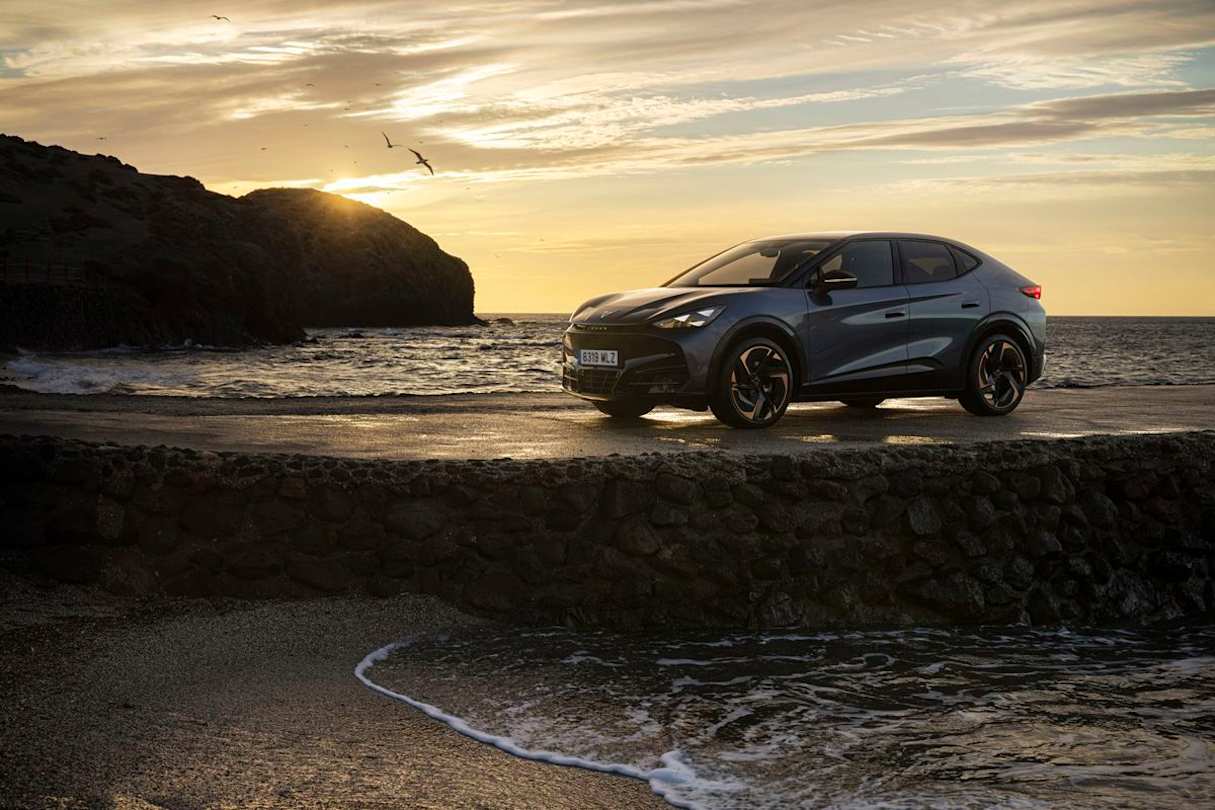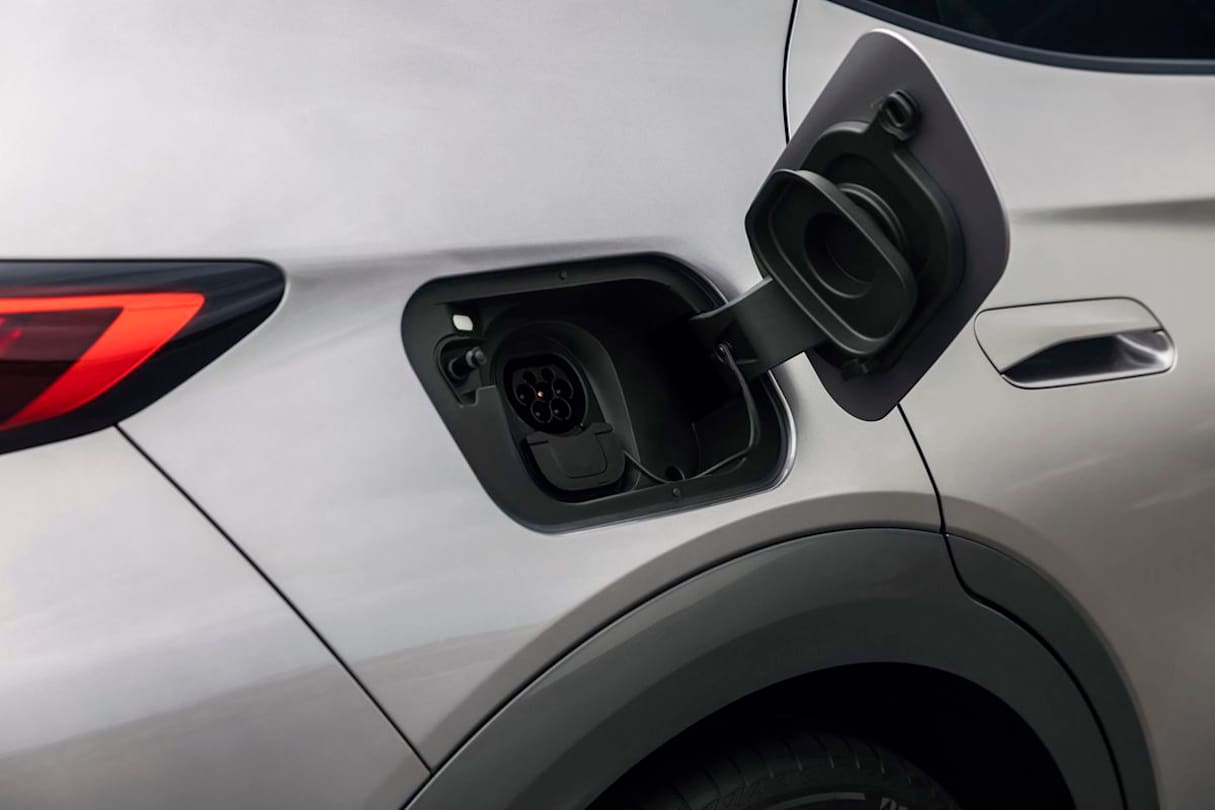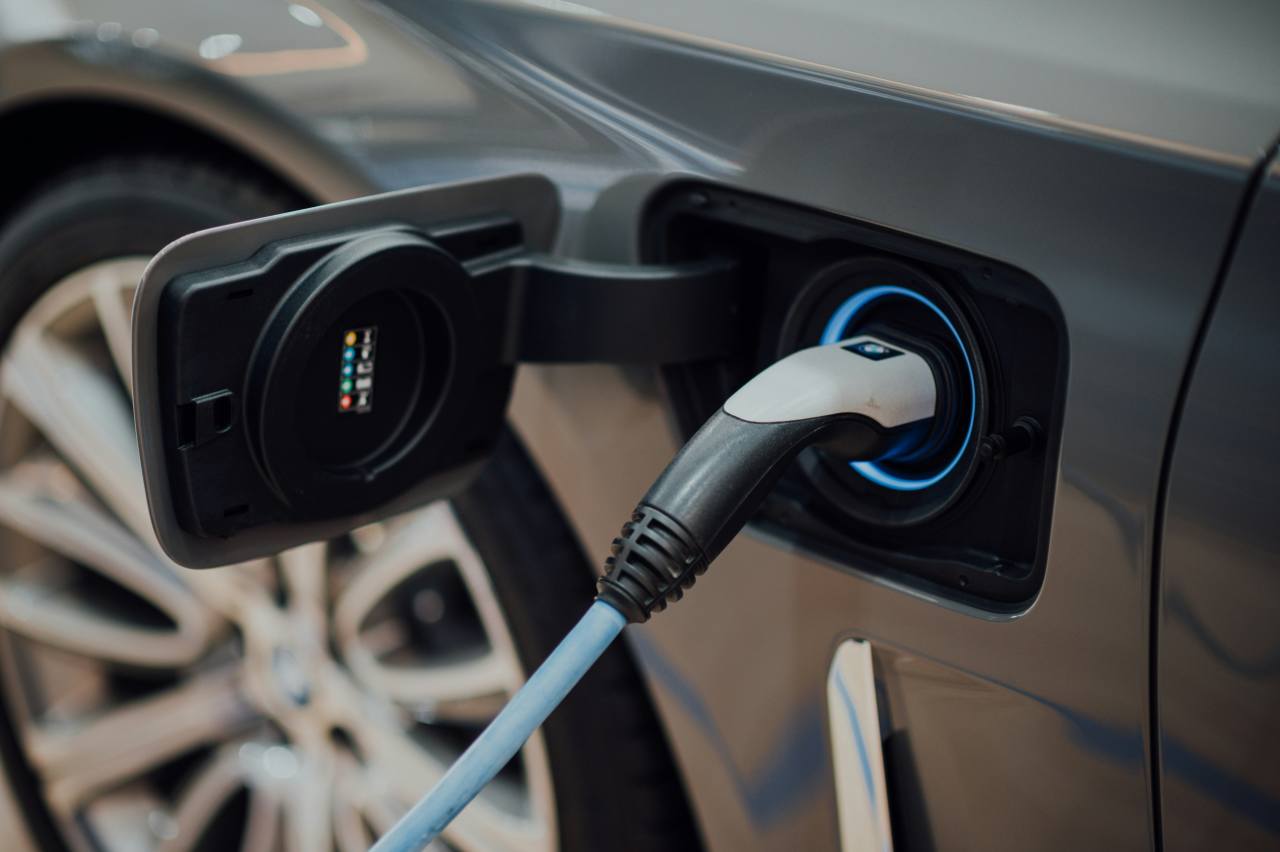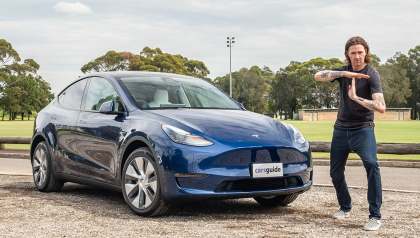Perhaps you’re reading this review because you’re genuinely interested in an electric mid-size SUV and you’re not sold on the Tesla Model Y but you want something with a bit more attitude than a Toyota bZ4X.
Well, the Cupra Tavascan is designed to fill exactly that niche.
A sporty mid-size SUV that doesn’t adhere to the norm.
Does it fulfil its goal and should it be on your list to test drive before you settle on an EV purchase? We drove it in its home market of Spain to find out.
Price and features – Does it represent good value for the price? What features does it come with? 7/10
7 / 10
As we’re testing the Tavascan ahead of its Australian launch, pricing was yet to be announced at the time of publication. However, the local Cupra division tells us to expect pricing to start north of $65,000.
This would line-up with, if not be a bit more affordable than, versions sold in Europe. If this ends up being the case it wouldn’t be surprising as the Tavascan is the only MEB-platform vehicle to be exported from China. Which is advantageous thanks to Australia's relative proximity.

You can also expect the Tavascan to arrive in two grades. There will be a base rear-wheel-drive Endurance grade, and a top-spec performance-focused all-wheel-drive VZ.
As with other Cupras, you can expect the standard equipment to be high. A 77kWh battery delivers up to 566km of driving range, which is a great start, and inside you'll find such refinements as bucket-style seats clad in sustainable synthetic materials, a massive 15-inch multimedia touchscreen with wireless Apple CarPlay and Android Auto, a 5.3-inch digital instrument cluster, tri-zone climate control, a wireless phone charger, ambient interior lighting, keyless entry and start, built-in navigation, and an auto-dimming rear-vision mirror, at least if the specification matches that of the base version sold in Spain.
.jpg)
Check back at the local launch before the end of 2024 to see the full equipment (which may roll in some of the pack-based options from overseas), but even the base cars in Spain get exterior highlights like 19-inch alloys with sporty tyres and tinted windows.
The VZ, meanwhile, steps up to add a second motor on the front axle for a significant power bump. We expect this car to sit closer to the $90,000 mark. Overseas it scores additional equipment like enlarged 20-inch alloy wheels, matrix LED headlights, sportier seats, progressive steering, and sports suspension. Its additional performance comes with a moderate hit to driving range, with overseas VZ versions having an estimated 521km between charges.
.jpg)
So, yes, we don’t have official pricing yet, and it’s clear this EV will come well equipped, but it won’t be the most affordable option in the market, and is facing abundant competition.
A Tesla Model Y, which is roughly the same size, can be had from $55,900 (before on-road costs) at the time of writing, for example, and there's also the Subaru Solterra (from $69,990), Toyota bZ4X (from $66,000), the Skoda Enyaq (from $69,990), and soon, the Kia EV5, which is yet to be priced.
Design – Is there anything interesting about its design? 8/10
8 / 10
This era of EVs has brought with it some seriously unconventional designs, yet the Tavascan still manages to stand out.
Part of Cupra’s brand promise is to be provocative and throw tradition to the wind, and there’s no denying the Tavascan is an unusual-looking SUV, even for a coupe.
It looks like it blends inspiration from the animal kingdom in with the more aggressive elements from the car world. Its face looks almost scorpion-like, with a texture in its grille and bodywork that looks like pincers grabbing the headlights. One particularly neat feature is the way its snout actually hides an integrated spoiler which runs underneath the front and up the bonnet on either side of the badge.
Cupra’s signature use of copper in its badgework is present, as is a blend of gloss, matt, and painted finishes, with the contrast blacks in particular rising up high on this SUV’s bodywork. Just describing it makes it sound ostentatious, and some people may think this, but I think it manages to hold a balance of its elements nicely. It’s worth looking at, but not so extreme it will draw controversy. If nothing else it looks distinct from its VW ID.4 and Skoda Enyaq relations.
Elsewhere, a set of aggressive and some two-tone wheel designs are matched by a tailgate that flicks into a spoiler shape, finished by a contemporary bar light with undeniably cool 3D-style light fittings and a continuation of the triangle pattern from the grille.
Inside things somehow get even more zany. The dash is defined by an extreme contour dipping from the rounded air vents at the edges to below the enormous touchscreen in the centre.
Here it meets one of the Tavascan’s signature design elements, a structural connecting piece that rises up from the centre console above the wireless phone chargers. Cupra calls this the Tavascan’s ‘spine’ and there’s no better way to describe the way it looks, as though a piece of the car’s skeleton is breaking through its flesh and holding up the dash in front of you.
Textured in scale it reinforces a raw, almost primordial feel to the cabin, which is contrasted, almost jarringly, by the abundance of tech. It’s here the Tavascan feels a bit overwhelming, and here where it may make or break the sale, but nobody can accuse it of being boring.

Practicality – How practical is its space and tech inside? 7/10
7 / 10
Despite its unusual design, the Tavascan offers a level of practicality that may surprise you, but it’s not the most spacious vehicle in this segment by a long shot.
Its interesting seat designs feel as though they have plenty of room for an adult. They’re finished in a blend of sustainable materials, including edges in a kind of neoprene rather than synthetic leather. This material clads the centre console giving a soft edge to the otherwise prickly look of all the sharp design elements.
For the seats themselves, it gains a bit of additional environmental cred perhaps, but truth be told, as cool as they look (with the copper triangle pattern inlays, too), they don’t breathe as well as real leather or even a lot of modern fabric seats.
Everything seems to be quite adjustable and should let most drivers find a seating position for them, but it is worth noting the windowline is quite high so shorter people may run into some visibility issues. Interestingly the digital dash element doesn’t sit atop the steering column like it does in other MEB cars, so it won’t move with the steering adjustment and may cause line of sight issues.
In terms of storage, there’s the wireless charger and a tray behind the ‘spine’, and in the centre console itself there are a set of two cupholders. They look like they form part of the design and have a lighting feature which is cool, but they aren’t massive and spillages will be a disaster with the curvature of the console itself.
Behind them is a split-opening centre console box which is narrow but deep. The doors also offer bottle holders with a small additional area for storage. Oddly, there’s an area underneath the wireless chargers which could have made for an additional storage tray, but is instead just carpeted floor. A missed opportunity, but I suppose this isn’t a Skoda.
The latest Cupra software is crisp and fast and suits the character of the car, but it is perhaps not quite as logically laid out as some other brands, even inside the Volkswagen Group. On top of this, there are basically no buttons aside from the ones on the steering wheel, so adjustment of key climate functions and volume are done via the touch sliders which sit below the screen. Never ideal, and potentially distracting while you’re on the go.
The back seat offers a solid amount of legroom for someone my height at 182cm tall. The descending roofline comes a little close to my head, so you wouldn’t want to be too much taller, although the width on offer seems above par for this class.
In addition, the floor is flat and the comfy seat claddings continue to the rear, making the centre position actually usable by an adult in a pinch.
The rear does feel a bit smaller than it actually is because of the abundance of dark trims and the big bucket-style front seats. Additionally, the rear of the centre console juts into the space a little.
Amenities are decent, with a large bottle holder in each door pocket on the backs of the front seats, a separate climate zone with its own controller and dual adjustable air vents on the back of the centre console.
The boot comes in at a large 540 litres. It swallowed a few pieces of luggage on our time travelling around the Spanish countryside, but we’ll deliver a final verdict on the space when we test it in Australia.
Under the bonnet – What are the key stats for its motor? 7/10
7 / 10
The Tavascan is offered with a 210kW/545Nm electric motor on the rear axle in its base Endurance form, while the VZ adds an 80kW electric motor on the front axle for a total of 250kW combined (and 675Nm of torque, although the two don’t combine so evenly so Cupra doesn’t offer it as an official figure.)
It’s plenty of power, but in practice doesn’t feel as overwhelming as the numbers suggest.
.jpg)
While the Tavascan shares its MEB underpinnings with the ID.4 and Enyaq, and feels a little like them as a result, there is some distinct hardware differences to help set it apart.
Cupra says it has more or less free reign to do its own steering and suspension tune, which is reflected on its other products, and helps to differentiate the Tavascan, too.
Driving – What's it like to drive? 8/10
8 / 10
These changes are evident enough once you get to driving the Tavascan which, like other Cupras, has sharp, accurate steering with good feedback, and a firmer ride than the ID.4, but more reactive as a result.
It doesn’t stray anywhere near the brittle ride quality of the Tesla Model Y, but with a bit more play available, you can also feel its gravity and the weight of its batteries a bit more in the corners.
We only sampled the all-wheel-drive VZ on our preview drive, and despite having the more powerful of the two drivetrains with what sounds like a whopping 250kW/675Nm theoretically available, it doesn’t feel anywhere near as break-neck fast as some EVs are, even in this category.

Some may be disappointed by its straight-line prowess, but what it has instead is a solid amount of acceleration tempered by clever traction settings and a more moderate roll-on to ensure it isn’t overwhelming to drive.
As much as it won’t pin you into the back of your seat, it also won’t launch itself forward into a wheelspin-induced surge, which can’t be said for every powerful EV.
While its moderated acceleration and hard, but balanced ride quality don’t make it sound as extreme as it could be, it does offer an element of play in the corners that some rival EVs filter out with even more locked-down suspension and traction settings.

As a result, perhaps what sets the Tavascan apart from many of its rivals is how it feels less like an EV and more like a car - I’m sure this is a trait that Cupra’s engineers were deliberately aiming for. It’s not like you’re just driving a computer, you’re driving a car that's happy to give you a semblance of an organic connection to the road, which is rare in the segment.
Adding to this is the moderate regenerative braking. This has to be one of the first electric vehicles I’ve driven where I barely noticed the regen in its default mode, it has a mild effect when you let off the acceleration, with a heavier effect blended in with the brake pedal. I tried the other modes, but had become so used to driving the Tavascan like a regular car anything higher or lower than what came with each drive mode felt inappropriate.

We had a chance to drive the Tavascan back-to-back against a Born VZ which is much more locked down and offers effectively the same powertrain in a much lower, lighter package. So for a keen driver I’d recommend you choose the hatch at the end of the day, but the Tavascan at least offers something much more than just a re-branded ID.4, and an EV that won’t go awry in the hands of someone who enjoys driving.

Refinement - likely due to good tyre choices and a generally thorough approach to sound deadening (as most VW Group products have) - is notable, making for a quiet and generally comfortable cabin.
Where does this leave our Tavascan? I must admit I frequently underestimate Cupra. What should be just rebadged VW products are tweaked in lots of little subtle areas, which add up to a transformed experience, and always one that favours the driving enthusiast.
Efficiency – What is its driving range? What is its charging time? 8/10
8 / 10
Efficiency numbers for the Australian market are yet to be confirmed. Overseas, RWD versions consume a WLTP combined 15.2kWh/100km, which, if carried over to the Australian market, would be excellent for an SUV this size.
The AWD VZ version meanwhile ups energy consumption to a still-impressive 16.5kWh/100km.

Range, again not locked in for Australian specifications, is a healthy 566km for the RWD or 521km for the VZ AWD, according to WLTP measurements on Euro-market cars.
Charging happens on a DC fast unit at a max rate of 135kW, making for a 10 to 80 per cent charge time in around half an hour. On a slower AC socket expect 11kW of charging capability, for a full charge from 10 per cent in more like six hours.
The Tavascan, as far as we can tell, doesn’t offer V2L, but check back for the local spec when it launches.
Safety – What safety equipment is fitted? What is its safety rating? 8/10
8 / 10
The Tavascan will ship with a healthy array of active safety equipment including autobahn-speed auto emergency braking, lane keep assist, blind spot monitoring, and rear cross traffic alert.
Expect extras like traffic sign recognition, front cross-traffic alert, exit assist and driver fatigue detection, although it only gets a reversing camera rather than a full 360-degree suite.
The Tavascan is yet to be rated by ANCAP or even Euro NCAP so check back after its local launch to see how it fares.
Ownership – What warranty is offered? What are its service intervals? What are its running costs? 7/10
7 / 10
Expect the usual five years and unlimited kilometres of warranty, and likely eight years and 160,000km to cover the battery.
You’ll have to tune back in at the Tavascan’s local arrival in Australia for full details on its service intervals and pricing, but it's Skoda equivalent, the Enyaq, only requires a service once every 24 months or 30,000km.
Verdict
It’s unusual, a little divisive, and I can see how it might not be for everyone, but maybe that’s the point. Cupra has thrown a wildcard into the Australian mid-size EV market with the Tavascan.
As it stands though, it seems competitive, and the VZ in particular may subvert at least some expectations for how much fun an electric SUV can be to drive.
Note: CarsGuide attended this event as a guest of the manufacturer, with travel, accommodation and meals provided.
Pricing Guides

Range and Specs
| Vehicle | Specs | Price* |
|---|---|---|
| Endurance | Electric, 1 SPEED AUTOMATIC | $60,990 |
| Endurance (interior Package) | Electric, 1 SPEED AUTOMATIC | $65,490 |
| VZ | Electric, 1 SPEED AUTOMATIC | $74,490 |


.jpg)
.jpg)



.jpg)
.jpg)




























.jpg)
.jpg)






